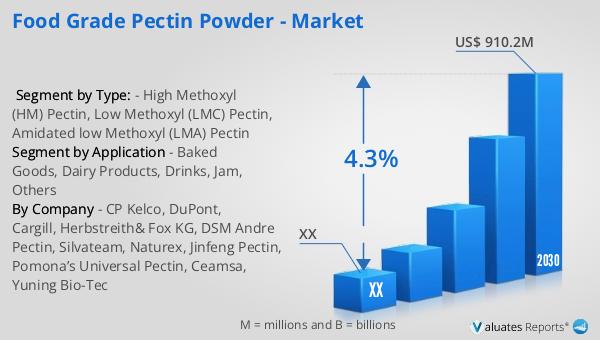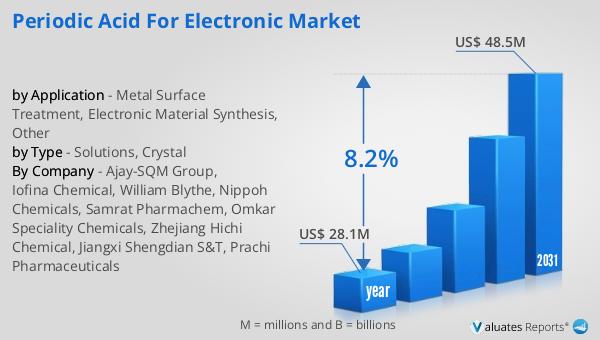What is Food Grade Pectin Powder - Global Market?
Food grade pectin powder is a natural carbohydrate substance derived from the cell walls of fruits, primarily apples and citrus fruits. It is widely used in the food industry as a gelling agent, thickener, and stabilizer. This versatile ingredient is essential in the production of jams, jellies, and marmalades, where it helps achieve the desired consistency and texture. Beyond its traditional uses, food grade pectin powder is also employed in the creation of low-sugar and sugar-free products, catering to the growing demand for healthier food options. The global market for food grade pectin powder is expanding due to increasing consumer awareness about the benefits of natural ingredients and the rising popularity of plant-based diets. Additionally, the clean label trend, which emphasizes transparency and simplicity in food labeling, has further boosted the demand for pectin as a natural additive. As a result, manufacturers are investing in research and development to innovate and improve pectin extraction and processing techniques, ensuring a steady supply to meet the growing market needs. The global market for food grade pectin powder is poised for significant growth, driven by its wide range of applications and the increasing consumer preference for natural and sustainable food ingredients.

High Methoxyl (HM) Pectin, Low Methoxyl (LMC) Pectin, Amidated low Methoxyl (LMA) Pectin in the Food Grade Pectin Powder - Global Market:
High Methoxyl (HM) Pectin, Low Methoxyl (LMC) Pectin, and Amidated Low Methoxyl (LMA) Pectin are three primary types of pectin used in the food industry, each with distinct properties and applications. High Methoxyl Pectin is characterized by a high degree of esterification, typically above 50%. This type of pectin requires a high sugar concentration and acidic conditions to gel, making it ideal for traditional jams and jellies. Its ability to form a gel at higher temperatures is beneficial for products that require heat processing. HM pectin is also used in confectionery products, where it provides a firm texture and enhances flavor release. On the other hand, Low Methoxyl Pectin has a lower degree of esterification, usually below 50%, and can gel in the presence of calcium ions rather than sugar. This makes LMC pectin suitable for low-sugar or sugar-free products, catering to health-conscious consumers. It is commonly used in dairy products like yogurts and desserts, where it helps achieve a creamy texture without the need for high sugar content. Amidated Low Methoxyl Pectin is a modified form of LMC pectin, where some of the carboxyl groups are converted to amides. This modification allows LMA pectin to gel at lower calcium concentrations and provides greater flexibility in processing conditions. LMA pectin is particularly useful in products that require a stable gel structure over a wide range of pH levels and temperatures. It is often used in fruit preparations, bakery fillings, and low-calorie spreads. The global market for these types of pectin is driven by the increasing demand for natural and clean label ingredients, as well as the growing trend towards healthier food options. Manufacturers are focusing on developing innovative pectin solutions to meet the diverse needs of the food industry, ensuring that each type of pectin is optimized for its specific application. As consumer preferences continue to evolve, the demand for HM, LMC, and LMA pectin is expected to grow, offering significant opportunities for market expansion.
Baked Goods, Dairy Products, Drinks, Jam, Others in the Food Grade Pectin Powder - Global Market:
Food grade pectin powder is a versatile ingredient with a wide range of applications in various food products, including baked goods, dairy products, drinks, jams, and other categories. In baked goods, pectin is used as a fat replacer and moisture retainer, helping to improve the texture and shelf life of products like cakes, muffins, and pastries. It also acts as a stabilizer in gluten-free baked goods, providing structure and preventing crumbling. In dairy products, pectin is commonly used in yogurts, puddings, and custards to enhance creaminess and prevent whey separation. Its ability to form a gel in the presence of calcium ions makes it ideal for low-sugar and reduced-fat dairy products, catering to health-conscious consumers. In the beverage industry, pectin is used as a stabilizer and thickener in fruit juices, smoothies, and flavored drinks. It helps maintain a uniform consistency and prevents sedimentation, ensuring a pleasant drinking experience. Pectin is also used in the production of jams and jellies, where it acts as a gelling agent to achieve the desired texture and consistency. Its ability to form a gel in the presence of sugar and acid makes it essential for traditional jam recipes. Additionally, pectin is used in a variety of other food products, such as sauces, dressings, and confectionery items, where it provides thickening and stabilizing properties. The global market for food grade pectin powder is driven by the increasing demand for natural and clean label ingredients, as well as the growing trend towards healthier food options. As consumers become more health-conscious and seek out products with fewer artificial additives, the demand for pectin as a natural ingredient is expected to rise. Manufacturers are focusing on developing innovative pectin solutions to meet the diverse needs of the food industry, ensuring that pectin remains a key ingredient in a wide range of food products.
Food Grade Pectin Powder - Global Market Outlook:
The global market for food grade pectin powder was valued at approximately $672 million in 2023. It is projected to grow to a revised size of around $910.2 million by 2030, reflecting a compound annual growth rate (CAGR) of 4.3% during the forecast period from 2024 to 2030. This growth is driven by the increasing demand for natural and clean label ingredients, as well as the rising popularity of plant-based diets. The North American market for food grade pectin powder was also valued at a significant amount in 2023 and is expected to continue growing at a steady pace through 2030. The exact figures for the North American market were not specified, but it is anticipated to follow a similar growth trajectory as the global market. The demand for pectin in North America is fueled by the growing consumer preference for healthier food options and the increasing use of pectin in a variety of food products. As manufacturers continue to innovate and develop new pectin solutions, the market is expected to expand, offering significant opportunities for growth and development.
| Report Metric | Details |
| Report Name | Food Grade Pectin Powder - Market |
| Forecasted market size in 2030 | US$ 910.2 million |
| CAGR | 4.3% |
| Forecasted years | 2024 - 2030 |
| Segment by Type: |
|
| Segment by Application |
|
| By Region |
|
| By Company | CP Kelco, DuPont, Cargill, Herbstreith& Fox KG, DSM Andre Pectin, Silvateam, Naturex, Jinfeng Pectin, Pomona’s Universal Pectin, Ceamsa, Yuning Bio-Tec |
| Forecast units | USD million in value |
| Report coverage | Revenue and volume forecast, company share, competitive landscape, growth factors and trends |
